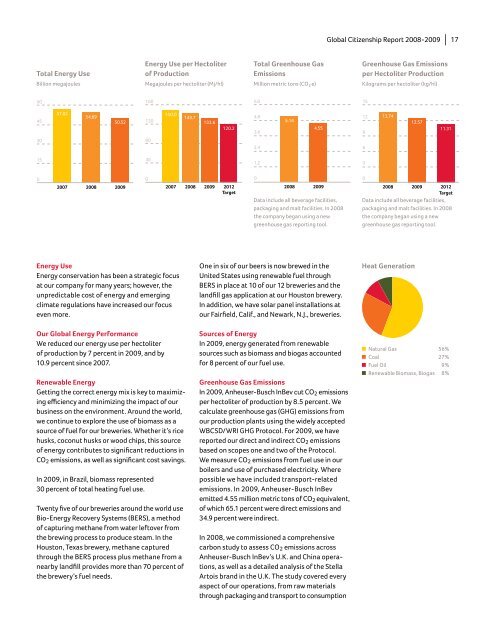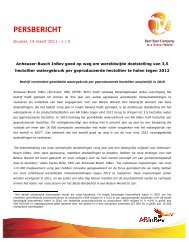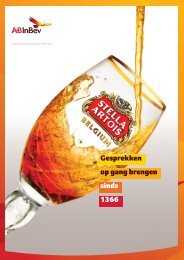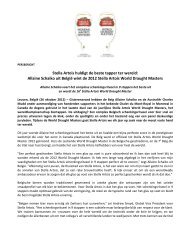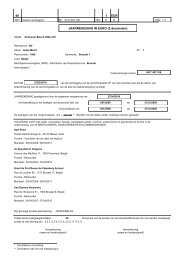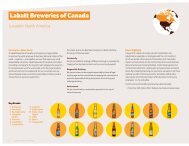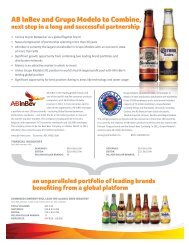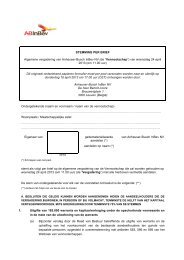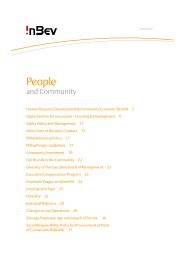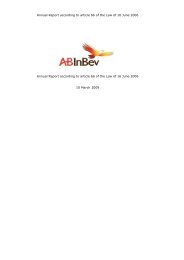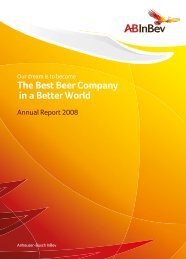Beer & A Better World - Anheuser-Busch InBev
Beer & A Better World - Anheuser-Busch InBev
Beer & A Better World - Anheuser-Busch InBev
Create successful ePaper yourself
Turn your PDF publications into a flip-book with our unique Google optimized e-Paper software.
Total Energy Use<br />
Billion megajoules<br />
60<br />
45<br />
30<br />
15<br />
0<br />
57.02<br />
54.69<br />
50.52<br />
2007 2008 2009<br />
Energy Use<br />
Energy conservation has been a strategic focus<br />
at our company for many years; however, the<br />
unpredictable cost of energy and emerging<br />
climate regulations have increased our focus<br />
even more.<br />
Our Global Energy Performance<br />
We reduced our energy use per hectoliter<br />
of production by 7 percent in 2009, and by<br />
10.9 percent since 2007.<br />
Renewable Energy<br />
Getting the correct energy mix is key to maximizing<br />
efficiency and minimizing the impact of our<br />
business on the environment. Around the world,<br />
we continue to explore the use of biomass as a<br />
source of fuel for our breweries. Whether it’s rice<br />
husks, coconut husks or wood chips, this source<br />
of energy contributes to significant reductions in<br />
CO2 emissions, as well as significant cost savings.<br />
In 2009, in Brazil, biomass represented<br />
30 percent of total heating fuel use.<br />
Energy Use per Hectoliter<br />
of Production<br />
Megajoules per hectoliter (Mj/hl)<br />
160<br />
120<br />
Twenty five of our breweries around the world use<br />
Bio-Energy Recovery Systems (BERS), a method<br />
of capturing methane from water leftover from<br />
the brewing process to produce steam. In the<br />
Houston, Texas brewery, methane captured<br />
through the BERS process plus methane from a<br />
nearby landfill provides more than 70 percent of<br />
the brewery’s fuel needs.<br />
80<br />
40<br />
0<br />
150.0<br />
143.7<br />
133.6<br />
120.2<br />
2007 2008 2009 2012<br />
Target<br />
Total Greenhouse Gas<br />
Emissions<br />
Million metric tons (CO2 e)<br />
6.0<br />
4.8<br />
3.6<br />
2.4<br />
1.2<br />
0<br />
5.14<br />
4.55<br />
2008 2009<br />
Data include all beverage facilities,<br />
packaging and malt facilities. In 2008<br />
the company began using a new<br />
greenhouse gas reporting tool.<br />
One in six of our beers is now brewed in the<br />
United States using renewable fuel through<br />
BERS in place at 10 of our 12 breweries and the<br />
landfill gas application at our Houston brewery.<br />
In addition, we have solar panel installations at<br />
our Fairfield, Calif., and Newark, N.J., breweries.<br />
Sources of Energy<br />
In 2009, energy generated from renewable<br />
sources such as biomass and biogas accounted<br />
for 8 percent of our fuel use.<br />
Greenhouse Gas Emissions<br />
In 2009, <strong>Anheuser</strong>-<strong>Busch</strong> <strong>InBev</strong> cut CO2 emissions<br />
per hectoliter of production by 8.5 percent. We<br />
calculate greenhouse gas (GHG) emissions from<br />
our production plants using the widely accepted<br />
WBCSD/WRI GHG Protocol. For 2009, we have<br />
reported our direct and indirect CO2 emissions<br />
based on scopes one and two of the Protocol.<br />
We measure CO2 emissions from fuel use in our<br />
boilers and use of purchased electricity. Where<br />
possible we have included transport-related<br />
emissions. In 2009, <strong>Anheuser</strong>-<strong>Busch</strong> <strong>InBev</strong><br />
emitted 4.55 million metric tons of CO2 equivalent,<br />
of which 65.1 percent were direct emissions and<br />
34.9 percent were indirect.<br />
In 2008, we commissioned a comprehensive<br />
carbon study to assess CO2 emissions across<br />
<strong>Anheuser</strong>-<strong>Busch</strong> <strong>InBev</strong>’s U.K. and China operations,<br />
as well as a detailed analysis of the Stella<br />
Artois brand in the U.K. The study covered every<br />
aspect of our operations, from raw materials<br />
through packaging and transport to consumption<br />
Global Citizenship Report 2008-2009 | 17<br />
Greenhouse Gas Emissions<br />
per Hectoliter Production<br />
Kilograms per hectoliter (kg/hl)<br />
15<br />
12<br />
9<br />
6<br />
3<br />
0<br />
13.74<br />
12.57<br />
11.31<br />
2008 2009 2012<br />
Target<br />
Data include all beverage facilities,<br />
packaging and malt facilities. In 2008<br />
the company began using a new<br />
greenhouse gas reporting tool.<br />
Heat Generation<br />
Natural Gas 56%<br />
Coal 27%<br />
Fuel Oil 9%<br />
Renewable Biomass, Biogas 8%


